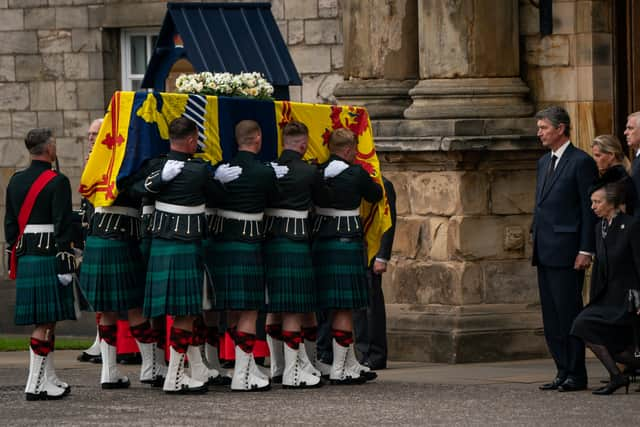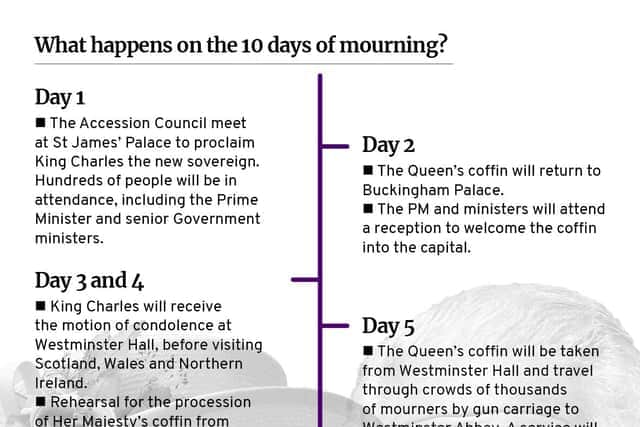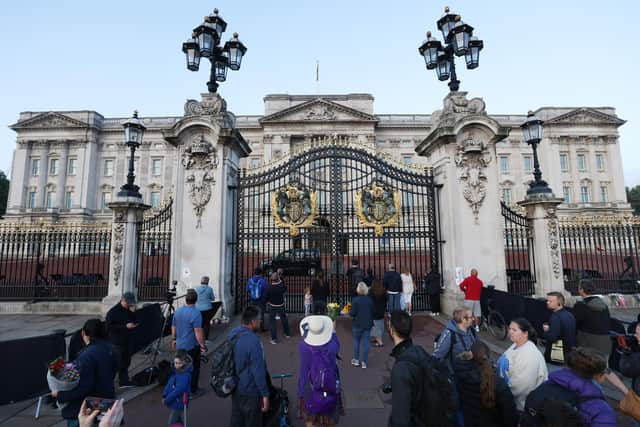Operation London Bridge: day-by-day plan of national mourning for the Queen and meaning of code name explained
and live on Freeview channel 276
The UK is in a period of national mourning after the death of Queen Elizabeth II. Britain’s longest reigning monarch passed away peacefully on Thursday 8 September.
The 96-year-old had celebrated her Platinum Jubilee in June, but concern had been growing in the months that followed due her deteriorating health. Following her death, Operation London Bridge commenced. The plan was established in the 1960s and outlines protocols in the event of The Queen’s death.
Advertisement
Hide AdAdvertisement
Hide AdIt also helps give the British public an idea of what they can expect in the coming days. Here’s everything you need to know about Operation London Bridge and the day-by-day plans ahead.
What is Operation London Bridge?
Operation London Bridge was devised in the 1960s as a plan of protocols to follow after The Queen died. Named after the famous London landmark, it outlines the announcement of the Queen’s death, the official mourning period, preparations and details of the state funeral. The plan gives guidance on everything, including key parts of King Charles III accession to the throne.
The day-by-day plan of national mourning for the Queen:
Operation London Bridge has put in place a plan for 10 days of national mourning after The Queen’s death. According to Politico, each of these days will be marked by events to commemorate the late monarch and enact plans for Charles’s accession as King Charles III, which is known as Operation Spring Tide. Here is the day-by-day plan of Operation London Bridge:
Day one - Saturday 10 September
The first day of mourning was held on Saturday 10 September, as The Queen died after 6pm on Thursday. The Accession Council met at St James’ Palace at 10am to announce King Charles as the new monarch. Privy counsellors, including the prime minister, were in attendance, with morning dress and black lounge suits worn.
Advertisement
Hide AdAdvertisement
Hide AdKing Charles held his first Privy council along with his wife Camillia the Queen Consort and his son Prince William. The first public proclamation of the new King was read from St James’s Palace by the Garter King of Arms.
It has also been announced that the country will get a new bank holiday to mark the Queen’s funeral after King Charles III approved an order during the Accession Council at the State Apartments at St James’s Palace on Saturday.
Day two - Sunday 11 September


The Queen’s coffin travelled to the Palace of Holyroodhouse in Edinburgh, making a six-hour journey from Balmoral in Aberdeenshire. Proclamations were read in the devolved parliaments in Scotland, Wales and Northern Ireland.
Day three - Monday 12 September
King Charles III will receive the motion of condolence at Westminster Hall. He will begin a tour of the UK, starting in Scotland, where he will attend a service at St. Giles’ Cathedral in Edinburgh. He will meet Scottish First Minister Nicola Sturgeon and will receive a message of condolence at the Scottish parliament. Prime minister Liz Truss will join him in a service of reflection in Scotland.
Advertisement
Hide AdAdvertisement
Hide AdThe Queen’s coffin will be taken in a procession along Royal Mile in Ediburgh to St Giles’ Cathedral, where it will lie for 24 hours. There will be a service and the Vigil of the Princes by members of the royal family. Members of the public will be able to pay their respects. They will get the chance to file past the Queen’s coffin at a mini lying in state in St Giles’.
After leaving England and visiting Scotland, Charles will at some stage travel to the other countries of the UK – Wales and Northern Ireland – known as Operation Spring Tide.
The House of Commons and the House of Lords are expected to come together in Westminster for a Motion of Condolence, which the King could attend.


Day four - Tuesday 13 September
The Queen’s coffin will make the journey to London by RAF plane. It will be accompanied by her only daughter Princess Anne and is due to arrive shortly before 7pm at RAF Northolt, before being taken to Buckingham Palace.
Advertisement
Hide AdAdvertisement
Hide AdA rehearsal for the procession of the coffin from Buckingham Palace to the Palace of Westminster will take place.
King Charles III will visit Northern Ireland, where he’ll receive another motion of condolence at Hillsborough Castle and attend a service at St. Anne’s Cathedral in Belfast.
A rehearsal will take place for the procession of the coffin from Buckingham Palace to the Palace of Westminster.
Day five - Wednesday 14 September


The Queen’s coffin will go on a procession through London from Buckingham Palace to the Palace of Westminster, arriving at 2pm. A service will be held in Westminster Hall following the coffin’s arrival.
Advertisement
Hide AdAdvertisement
Hide AdThe Queen’s lying in state is expected to begin in Westminster Hall – Operation Marquee – following a ceremonial procession through London. It will last four full days. The Archbishop of Canterbury will conduct a short service following the coffin’s arrival.
Hundreds of thousands of people will file past the coffin and pay their respects, with the management of the queues outside known as Operation Feather. Senior royals are expected to pay their own moving tribute, standing guard at some stage around the coffin – which is the tradition known as the Vigil of the Princes.
Days six to nine - 15 September to 18 September
The Queen will lie in state at the Palace of Westminster for three days. Members of the public will be able to pay their respects, with Westminster Hall open to the public for 23 hours a day.
King Charles will travel to Wales to receive another motion of condolence at the Welsh parliament and attend a service at Llandaff Cathedral in Cardiff. Heads of state will begin to arrive for the funeral on Monday 19 September.
Day 10 - Monday 19 September
Advertisement
Hide AdAdvertisement
Hide AdThe date for the Queen’s state funeral has been confirmed by Buckingham Palace: it will take place on the tenth day of mourning which is Monday 19 September. The state funeral will take place at Westminster Abbey, with a two minutes’ silence held across the UK at midday. The day will be a UK bank holiday.
Funeral processions will take place in London and Windsor, with a service in St. George’s Chapel at Windsor Castle. The Queen will be laid to rest in Windsor’s King George VI Memorial Chapel.
The original plans are for the Queen’s coffin to process on a gun carriage to the abbey, pulled by sailors using ropes rather than horses. Senior members of the family are expected to follow behind. The military will line the streets and also join the procession.
Heads of state, prime ministers and presidents, European royals and key figures from public life will be invited to gather in the abbey, which can hold a congregation of 2,000. The service will be televised, with people around the globe tuning in.
Advertisement
Hide AdAdvertisement
Hide AdThe same day as the funeral, the Queen’s coffin will be taken to St George’s Chapel at Windsor Castle for a televised committal service. Later in the evening, there will be a private interment service with senior members of the royal family.
The Queen’s final resting place will be the King George VI memorial chapel, which is an annex to the main chapel where her mother and father were buried, along with the ashes of her sister, Princess Margaret. Prince Philip’s coffin will move from the Royal Vault to the memorial chapel to join the Queen’s.
Comment Guidelines
National World encourages reader discussion on our stories. User feedback, insights and back-and-forth exchanges add a rich layer of context to reporting. Please review our Community Guidelines before commenting.